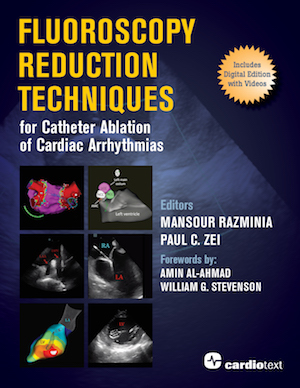Fluoroscopy Reduction Techniques for Catheter Ablation of Cardiac Arrhythmias - Razminia, Zei 9781942909309
Fluoroscopy Reduction Techniques for Catheter Ablation of Cardiac Arrhythmias - Razminia, Zei 9781942909309
Click here for immediate eBook access from Glassboxx.
Fluoroscopy Reduction Techniques + Hands-On Ablation - Print Bundle
ISBNs: 9781942909309 and 9781942909170
Fluoroscopy Reduction Techniques for Catheter Ablation of Cardiac Arrhythmias
Edited By Mansour Razminia, MD, and Paul C. Zei, MD, PhD
Product Details:
Publication Date: May 2019
ISBN: 9781942909309
eISBN: 9781942909354
Trim Size: 8.5 x 11
232 pages
Full color interior
Format: Paperback; eBook only
**To receive your free digital edition, if you purchased your book directly from Cardiotext, we will ship an access code with your print book. If purchased elsewhere, please send a copy of your receipt to info@cardiotext.com with subject line FLUOROLESS EBOOK, and we will email you a redemption code along with instructions on how to access the digital file. Please allow one business day for processing.
About:
Background:
Catheter ablation has become a widely used approach to treating various cardiac arrhythmias. Traditionally, catheter ablation procedures are guided by fluoroscopic imaging to help understand catheter position during mapping. The potentially significant exposure to radiation to the patient, physician, and staff increases risks of radiation exposure-related disease. Also, the protective lead garments worn increases risks of orthopedic injury. Current advanced electroanatomic mapping and intracardiac echocardiography technology have allowed the development of endocardial catheter ablation techniques without the use of fluoroscopy safely and effectively.
A host of expert and experienced authors present a practical overview of the rationale and methodology for a low- or zero-fluoro environment in the electrophysiology lab with the critical goal of significantly reducing radiation exposure to the patient, physician, and staff.
This practical guide:
Covers the entire spectrum of commonly (and less commonly) performed ablation procedures via endocardial approach.
Discusses general principles that are applicable across ICE and EAM platforms.
Will assist the electrophysiologist and their team to safely and effectively work toward the significant reduction in fluoroscopy utilization while also likely improving procedural safety, i.e., fewer complications, after the adoption of these techniques.
Includes a library of 50 videos, with 9 extended films (108 minutes) by Dr. Razminia detailing step-by-step procedures and techniques.
“An important text for all electrophysiologists, replete with crucial advice on the optimal use of nonfluoroscopic tools for better ablation safety and efficacy.”
- Amin Al-Ahmad, MD
“I congratulate Drs. Razminia and Zei on a wonderful contribution to the electrophysiology literature that will foster continued advances in the field that will improve safety and outcomes. This book is a wonderful source of guidance toward that goal.”
- William G. Stevenson, MD
Table of Contents
Section 1: Basis of Imaging in the Electrophysiology Lab
1 Radiation Safety in the Electrophysiology Lab
Kristen Breedlove, John Clark
2 How to Use Intracardiac Echocardiography to Reduce Fluoroscopy
Cameron Willoughby
3 How to Use Electroanatomic Mapping to Reduce Fluoroscopy
Kristen Breedlove, John Clark
4 How to Use Technologies such as MediGuide and CARTOUNIVU to Reduce Fluoroscopy During Catheter Ablation
Martin Borlich, Philipp Sommer
5 How to Obtain Central Vascular Access Using Real-time Ultrasound
Carola Gianni, Carlos Monreal, Zachary J. Rosenblatt, Jason T. Engel, Clayton Robison, Rodney P. Horton, Andrea Natale, Amin Al-Ahmad
6 How to Perform Transseptal Puncture Without Fluoroscopy
José Mauricio Sánchez
7 How to Maintain Safety With a Reduced Fluoroscopy Approach
José Osorio, Gustavo X. Morales
8 How to Monitor Esophageal Temperature Without Fluoroscopy
Oliver D’Silva, Hany Demo, Theodore Wang, Mansour Razminia
Section 2: Ablation of Supraventricular Tachycardia
9 How to Ablate Atrioventricular Nodal Reentrant Tachycardia Using No Fluoroscopy
Nicholas Von Bergen, Ian H. Law
10 How to Ablate Accessory Pathways Using No Fluoroscopy
Raman L. Mitra
11 How to Ablate Typical Atrial Flutter Using No Fluoroscopy
Saurabh Shah
12 How to Ablate Atrial Tachycardia and Atypical Flutter Using No Fluoroscopy
Dan Alyesh, Sri Sundaram
Section 3: Ablation of Atrial Fibrillation
13 How to Perform Radiofrequency Ablation of Atrial Fibrillation Using No Fluoroscopy
Robin Singh, Paul C. Zei
14 How to Perform Cryo-Balloon Ablation of Atrial Fibrillation Using No Fluoroscopy
Hany Demo, Oliver D’Silva, Mansour Razminia
Section 4: Ablation of Ventricular Arrhythmias
15 How to Perform Premature Ventricular Complex Ablation Originating From the Right Ventricle and Right Ventricular Outflow Tract Using No Fluoroscopy
Christopher I. Jones, Roderick Tung
16 How to Perform Ablation in the Coronary Cusps Using No Fluoroscopy
José Mauricio Sánchez
17 How to Perform Ablation of Premature Ventricular Complexes Originating from the Left Ventricular Outflow Tract Using No Fluoroscopy
Nicholas J. Costa, Jim W. Cheung
18 How to Perform Papillary Muscle Premature Ventricular Complex Ablation Using No Fluoroscopy
Oliver D'Silva, Hany Demo, Theodore Wang, Mansour Razminia
19 How to Perform Ablation of Ischemic and Non-Ischemic Ventricular Tachycardia Using No Fluoroscopy
Amit Thosani
Section 5: Special Populations
20 How to perform Catheter Ablation During Pregnancy: Special Considerations
John D. Ferguson
21 How to Perform Catheter Ablation in the Pediatric Population Using No Fluoroscopy
Nicholas Von Bergen, Ian H. Law
Errata Pages*
Errata Recap (PDF)
Errata Pages 48-49 (PDF)
Errata Page 124 (PDF)
Errata Page 127 (PDF)
*eBook files have been updated to include the errata pages above. If you have downloaded a version before 5/21/20, please delete from your app and download the corrected file.



